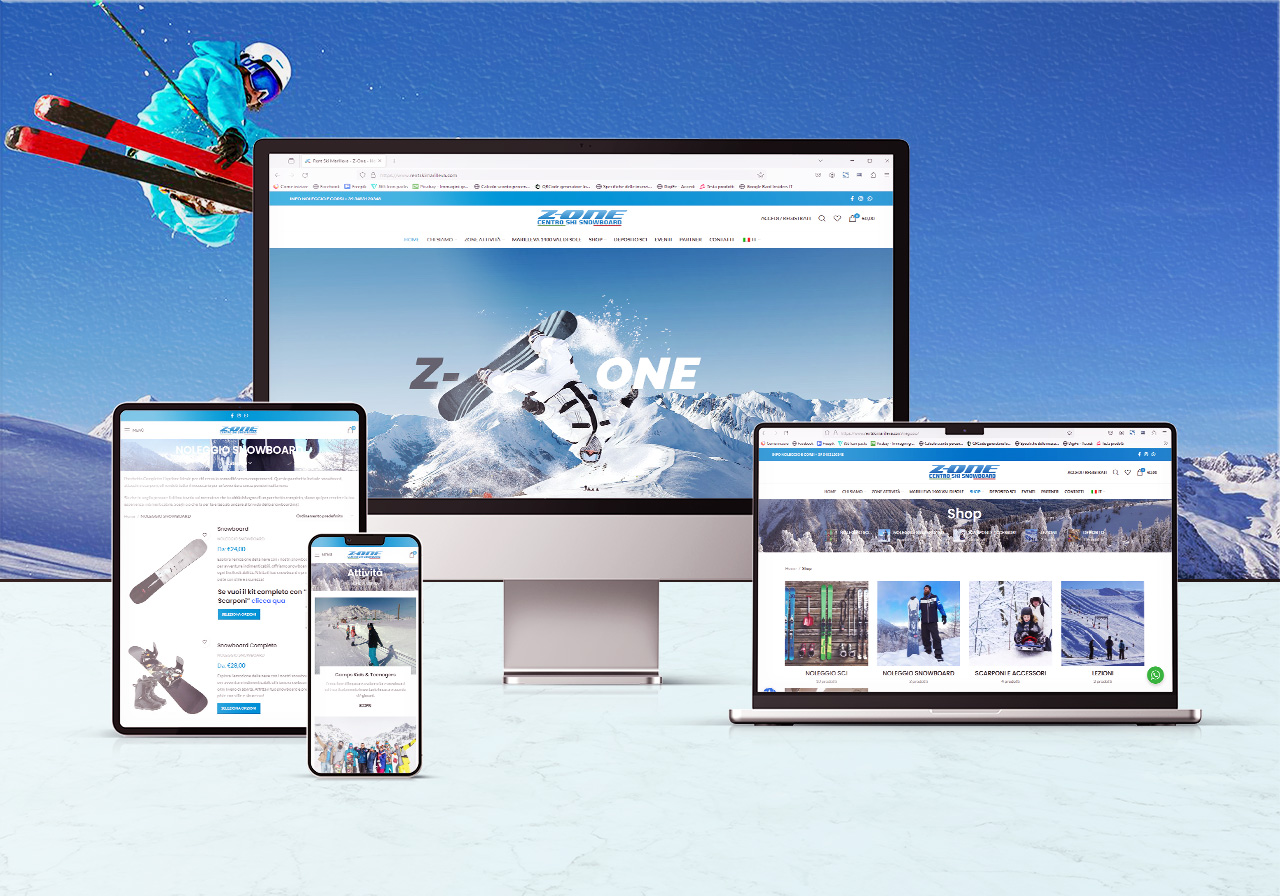
Creating an e-commerce site and managing it on a daily basis is a wonderful challenge. It allows you to learn practical skills in the field, which are difficult to convey from a master's degree in business management or a theoretical course. However, selling products online is also complex, and you often find yourself making avoidable mistakes.
In this article we will delve into everything you need to know to open and manage an e-commerce in 2025: the definition, the different types, the reference legislation, the marketing techniques and the ten most important tips to get off to a good start. For a customized project, you can contact Digife for a personalized quote.
What is an ecommerce? Meaning and definition
Ecommerce, short for “electronic commerce” (in Italian, electronic commerce), indicates the purchase and sale of goods and/or services via the Internet. Transactions can take place through websites, mobile apps, social networks, marketplaces, affiliate platforms and other online channels.
The concept began to spread in the late 1970s with the first electronic transactions. Today, e-commerce represents an entire infrastructure of online commercial relationships between sellers and buyers.
In Italy, e-commerce turnover reached 54.2 billion euros in 2025, up 13% compared to 2024 (source: Osservatori.net).
How does e-commerce work and what is the reference regulation?
An e-commerce includes different phases: marketing, positioning in search engines, customer care, payment management and logistics. In Italy, the main regulatory reference is the Legislative Decree 70/2003, which guarantees:
- Mandatory information on products, prices, payments, delivery costs and taxes;
- Method of conclusion of the contract;
- Obligation to confirm the order to the customer with a detailed summary;
- Right of withdrawal.
European regulations on the processing of personal data (GDPR) and tax regulations for intra-EU distance selling must also be taken into account.
Types of e-commerce
Direct and indirect e-commerce
- Direct: everything happens online, including the product (e.g. video courses, ebooks, software);
- Indirect: the transaction takes place online, but the good is physical and is shipped.
Business models
- B2B: from company to company
- B2C: from company to consumer
- C2C: between consumers (e.g. marketplace)
- C2B, B2G, C2G, G2G, P2P: other less common but existing models.
The most popular model is the B2C, where an online store sells directly to end customers via electronic shopping carts and secure payments (SSL/TLS protocol).
Advantages of e-commerce
- 24/7 accessibility for customers, from any device;
- Wide range: sell worldwide without physical locations;
- Personalization: data collection for targeted strategies;
- Lower costs: no rent, low running costs;
- Flexible models: dropshipping, print on demand and digital products.
An ecommerce is also a very powerful branding and loyalty tool. Thanks to CRM, automation and retargeting, it is possible to manage customer life cycles in a much more thorough way than a physical store.
The main challenges of e-commerce
- Safety: invest in SSL, secure payments, clear privacy policies;
- High competition: differentiating yourself is crucial;
- Logistics: rely on efficient and reliable couriers;
- Returns and customer service: clear policy and responsiveness make the difference.
Site loading speed, mobile optimization and a good UX are essential elements to compete today.
How to open an ecommerce
The best way to start an e-commerce is to use a professional ecommerce platform, or rely on an expert team. An ecommerce is not just a site: it is a complex system that includes backend, SEO, automation, email marketing and analytics.
Digife can accompany you in all phases: design, development, UX design, SEO, marketing strategies and integration with ERP and management systems.
How much does it cost to open an e-commerce?
Costs depend on several factors:
- Hosting and domain
- Design and development
- Legal obligations (VAT number, INPS, Chamber of Commerce, etc.)
- Marketing and promotion
The average initial investment varies between 5,000 and 15,000€ for a complete project. There are cheaper solutions for dropshipping or digital products.
Don't forget the INPS fixed costs (€3,850/year up to €15,953 of turnover, +24% of the excess income).
For an accurate evaluation, contact Digife for a free quote.
Best Selling Products Online in 2025
- Digital products: ebooks, courses, music, software, consultancy;
- Lightweight accessories: yoga mats, pet carriers, kitchen utensils;
- Gadgets and fashion: costume jewelry, homewear, backpacks, sneakers;
- Free time: board games, books, vinyl records.
For dropshipping: prefer standard, lightweight items with a low rate of returns.
10 tips for running an ecommerce business successfully
- Don't underestimate the financial part: useful formula → Profit = Demand × (Turnover – Expenses).
- Study the market and competitors: no to improvisation. Yes to market research and SEO.
- Choose your products carefully: few but well positioned. Segment the offer.
- Define a content strategy: blog, storytelling, informative posts. Build trust.
- Evaluate freebies wisely: they work on cosmetics, food, supplements. Not everything.
Giveaways can be a very powerful tool if included in a well-thought-out strategy. To work, they must be consistent with the brand and perceived as truly useful by the customer. For example, a skincare e-commerce site can include free samples of new products to encourage repurchase and discovery of the range, while an organic food e-commerce site can send tea bags or rare spices to encourage testing.
It is essential that each tribute:
- have a low marginal cost but a high perceived value;
- be carefully packaged and not simply as “warehouse leftovers”;
- be clearly communicated on the product page or in the cart, as an incentive to purchase;
- be traceable to measure conversions and loyalty.
Additionally, integrating giveaways into email campaigns, post-sales funnels, and social media can amplify the wow factor and strengthen the relationship with the customer.
An effective strategy involves using giveaways as leverage to:
- increase average cart value (e.g. “Get a gift for orders over €50”);
- encourage reviews (“Leave a review and receive a free product”);
- launch new products without direct advertising costs;
- reward regular customers in loyalty programs.
Inserting these elements in a structured way into your strategy allows you to transform the freebie from a simple cost into a powerful branding, engagement and conversion tool.
- Only run a contest if you have a plan
Contests can generate traffic, followers and leads, but they must be supported by a consistent content strategy. A contest without an editorial plan risks bringing ephemeral visibility.
Here's how to set up an effective contest:
- define a prize consistent with the target;
- use simple mechanisms (e.g. comment, share, tag);
- collect data for remarketing (e.g. email, preferences);
- announce the winner and thank them publicly;
- continue to feed the audience with post-contest content.
- Optimize your time: automate where you can. Avoid unnecessary perfectionism.
- Know your ideal customer: create a buyer persona. Write for her, not for yourself.
- Prepare a marketing plan: advertising, email, SEO, social. Don't improvise.
- Be wary of miracle solutions: Many agencies promise a lot. Few deliver.
Conclusion
Opening an e-commerce in 2025 means facing a competitive context, but also one full of opportunities. Success comes from the sum of multiple factors: strong brand identity, clear value proposition, fluid UX, integrated marketing strategies.
To receive a personalized quote or start an ecommerce project Contact Digife: we will help you transform your ideas into a successful and lasting online business.








